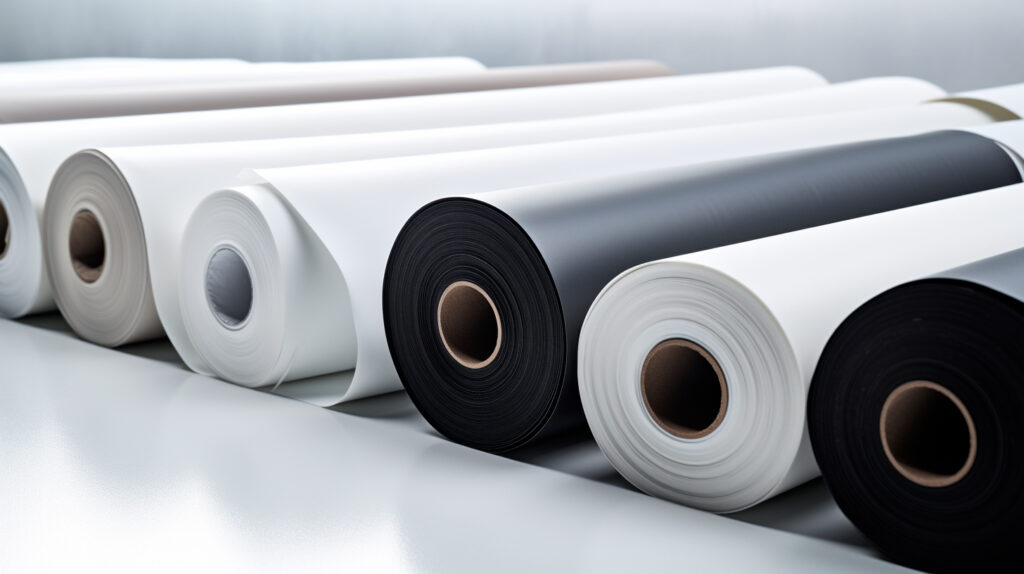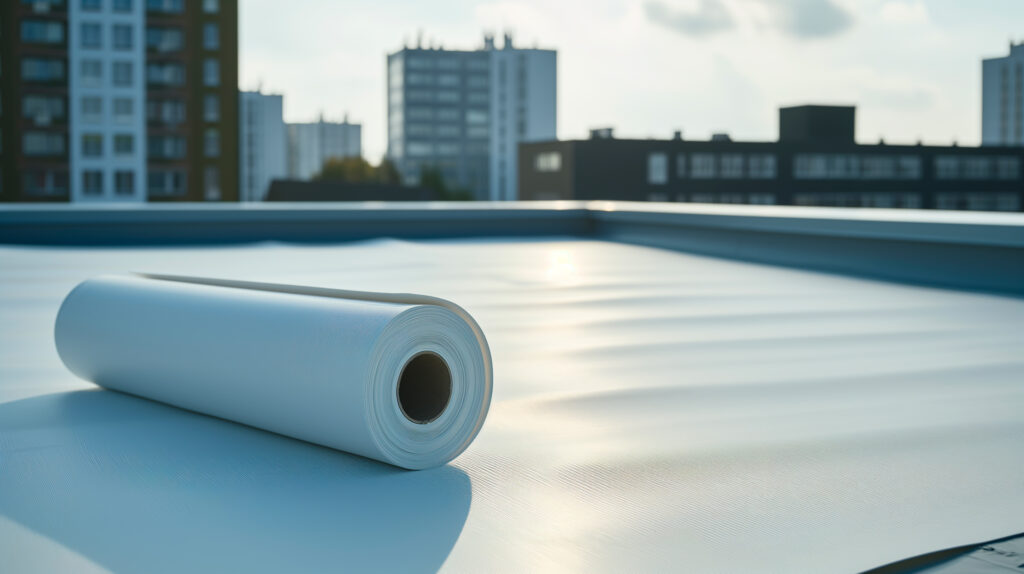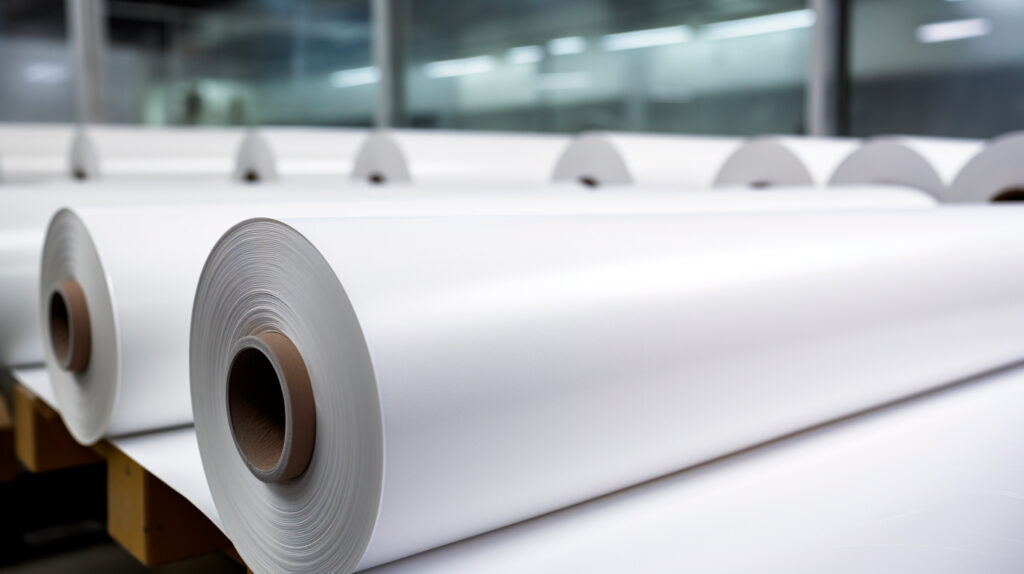PVC for Roofing: A Deep Dive into Single-Ply Membranes Including PVC, EPDM, and TPO
Reading Time: 5 minutesPVC, the pioneer of single-ply roofing membranes, first made its mark in the market with its reliable performance. As roofing technologies evolved, new materials emerged, challenging PVC’s dominance. Yet, the popularity of PVC for roofing applications continues to be significant, bolstered by technological advancements that have enhanced its durability, efficiency, and aesthetic appeal.

Single-ply roofing: PVC, EPDM, and TPO membranes
Single-ply membranes share many beneficial qualities: longevity, flexibility, ease of maintenance, and energy efficiency. Still, these parameters can vary significantly depending on the material.
| Material | Estimated Lifespan | Price Range ($ per square foot) | History & Reputation | |
| PVC or vinyl | Polyvinyl Chloride | 20–30 years | 8.50-14.50 | PVC is the initial type of single-ply membrane roof. Therefore, its reputation became the most trustworthy over the years. |
| EPDM or rubber roof | Ethylene Propylene Diene Monomer | 7.50-12.50 | EPDM roofs haven’t been on the market for long. Yet, they are the only ones who can withstand cold weather and frost. | |
| TPO | Thermoplastic Polyolefin | 15–20 years | 8.50-14.50 | TPO membranes are the most recent addition to single-ply roofing. As a result, they are the most up-to-date in terms of technology, but their lasting properties call for further research. |
Tips for Further Exploration
Of course, there are many other single-ply membranes. PVC, EPDM, and TPO are the most recognizable and widespread ones. For instance, you can explore CSPE, ECH, CR, and PIB roofing systems to get acquainted with other potential selections from this category.
Understanding the Benefits and Risks of PVC for Roofing
Naturally, there are other essential differences between the members of the single-ply roof family. Almost all of them stem from the material’s inherent characteristics. Thus, PVC’s unique traits determine its potential benefits and shortcomings.

Installation Process: Method & Potential Complications
Unlike many natural materials, PVC (polyvinyl chloride) allows you to choose from multiple installation methods. PVC roofing membranes can be mechanically attached, fully adhered, or welded with heat. Regardless of the method, the process won’t entail overly complex procedures, exhausting physical labor, or hazardous situations.
Although the installation is flame-free, you shouldn’t forget that this is a construction work. Hence, it requires a particular expertise and ability to utilize special instruments. Plus, working at height involves substantial risks. Therefore, safety measures and first-aid kits are mandatory for this job.

Necessary Preparation
- If you intend to stick with the fully adhered method, you should find a high-quality, lasting, and reliable adhesive.
- Fasteners cause puncturing. Thus, the places where a membrane is attached to the roof’s deck will be more vulnerable.
- Heat welding (infusion) requires special plates. Their coating will allow the induction to happen. Otherwise, the membrane won’t fuse with the surface.
- It would be best to refrain from installing and maintaining a PVC roof unless you can use specific tools necessary for these procedures.
Cautionary Sidenote
PVC roofing system is a low-maintenance solution. Still, roofing installed correctly will immensely prolong the lifespan of the whole structure.
You can use single-ply membranes only for low-slope or flat roofs. Water streams down naturally from steep slope roofs. Hence, you can opt for a more traditional roofing solution instead of a waterproof membrane.
Of course, you should start the installation process only after the roof deck and insulation are in place.
Protection Features of PVC for Roofing
PVC membrane forms a homogenous shield against many factors, deteriorating a roof and the whole building.
- This surface is completely waterproof and fire-resistant. In addition, its permeability properties keep chemicals and grease from transmitting through the membrane.
- It also neutralizes the damaging effects of heat and sunny days, such as UV rays and discoloration.
- You won’t encounter traditional enemies of roofing covers like rot, rust, moss, pests, bugs, or mold.
Bonus Point
PVC is recyclable and eco-friendly. As a result, it indirectly helps you protect the environment.
Possible Vulnerabilities
Although PVC roofing demonstrates impressive longevity and can serve you for up to 30 years, the first need for repair might occur after 10–15 years.
Cold climate and extremely low temperatures make the material fragile and more inclined to shatter. Thus, the best time to perform cleaning, inspections, or repairs is before and after winter months. Regular maintenance guarantees that your roof will reach the maximum of its potential life expectancy.

Protection Features in Upgrading PVC for Roofing Membranes in Boston, Massachusetts
If you live in Boston, Massachusetts, you know it has unpredictable weather. Generally, PVC can withstand almost any outside influence, including heat, high winds, snow, and rain. However, particular enhancements can turn a standard PVC membrane into a more durable, aesthetically pleasing, or practical solution.
PVC with Polyester Reinforcement
Polyester reinforcement improves the material’s resistance against wear, tear, and wind uplift. Moreover, these sheets will have advanced adhesion properties, and the fatigue won’t be noticeable.
PVC KEE Roofing
With time, plasticizers evaporate from the PVC membranes, causing the material to break. Hence, many manufacturers decided to add Ketone Ethylene Ester (KEE) to the general formula. This extra component helps to boost the membrane’s longevity, flexibility, and reflexivity.
Clarifying the Terms
Not every PVC membrane that contains the additional compound is a KEE roof. This term is only for the materials in which the amount of KEE surpasses 50% of the polymer content by weight.
Cool Roofing
PVC membranes come in various colors, but white demonstrates the highest albedo. With this solution, you can enjoy multiple advantages:
- This cover reduces energy costs and helps to preserve a comfortable temperature inside the premises. This feature makes it a perfect solution for commercial buildings or residential spaces with no necessity for extra heat (e.g., bedroom, garage, or patio).
- It neutralizes the thermal effect of accumulated heat in urban areas.
- Cool roofs will preserve their appearance longer than the ones exposed to high temperatures.
Green Roofing
This option significantly increases the cost of your roofing project. Yet, vegetation or a garden on top of your roof doesn’t only upgrade the aesthetic appeal of your building or boost its market value. It also helps make the roofing system more energy-efficient and durable:
- Plants filter the air and retain rainwater.
- An additional layer shields the membrane from the sun’s harmful effects, such as extensive heat and UV radiation.
Solar Roofing
You can easily mount solar panels on a rooftop with a PVC membrane. It is the most eco-friendly and energy-efficient solution available on the market. You use the sun’s rays as a renewable energy source instead of allowing it to damage the roof’s surface.
Gravel Roofing
This system implies you cover the PVC membrane with gravel as a ballast. It enhances the surface’s protection capacity against high winds, fire, water, and other outside impact. As a result, there is almost no need for maintenance due to a minimal chance of mechanical or other form of damage.
Final Thoughts
Overall, a PVC roofing system is well-suited for the environment in Boston, Massachusetts, as it withstands weather conditions like prolonged rain, heavy snowfall, and bright sunshine. It’s also customizable for added resilience, style, or practicality. For optimal results, consulting with professional roofers for installation and customization is crucial.
Denis is the driving force behind ID Flat Roof, a leading company in Boston specializing in flat roof repair and installation for over 20 years.
Expertise:
Denis excels in PVC, TPO, EPDM, and rubber roofing. His meticulous approach ensures quality and customer satisfaction.
Innovation:
Denis incorporates cutting-edge solutions like skylights and solar PV roofing.



